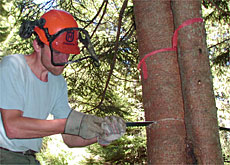Chopping down trees to save the forest

Many special events have been taking place this year in Switzerland to mark International Year of Mountains.
But it’s business as usual for one organisation, Mountain Forest Project, which has been bringing volunteers to the Alps for 15 years.
The volunteers learn how to use axes, saws and scythes, and learn by doing, gaining an appreciation of the importance of mountain forests to man and the environment.
While visiting a camp for volunteers set up on a steep mountain slope above the village of Elm in canton Glarus, the founder of Mountain Forest Project, Renato Ruf, insists that the non-profit organisation’s main goal is to “show people just how much man is dependent on the environment”.
“Without mountain forests, there would be no life in the mountains,” he adds. “The work is only a vehicle to bring them into the alpine forest so they can see what happens in a forest.”
Volunteers
According to Peter Locher, the managing director of Mountain Forest Project, about 1,000 volunteers from across Europe have left their comfortable office jobs for a week this summer to travel to places like Elm in the Swiss, German and Austrian Alps, where they work as volunteers.
“They’re aged between 18 and 88, and they come from all kinds of backgrounds,” says Locher. “We have musicians, lawyers, teachers and carpenters.”
“My generation doesn’t have the opportunity to get in touch with such things,” says Marco Danzi, who works for the public transport company in the Italian city of Turin.
“If you go into the mountains [as a tourist] you have a different approach – you use the mountains, your life isn’t dependent on them.”
Andreas von Löwenich, who works as an engineer for BMW in Munich, says he has volunteered to do something completely different from moving a computer mouse around a mouse pad.
Sore muscles and blisters
Sporting sore muscles and blisters to show for their efforts, neither Danzi nor von Löwenich is too tired to appreciate the fruits of their labour.
By chopping down weak fir trees they allow healthy ones to spread their roots and new trees to grow which strengthens the forest as a whole making it more resistant to natural disasters.
Avalanche barrier
A healthy forest acts as a barrier against landslides in summer and avalanches in winter.
The team also tend to the alpine meadows bordering the forest. By cutting the grass, they promote the new growth of wildflowers, which deer and chamois graze on.
This lessens the damage wildlife does to the forest by eating tree shoots, giving saplings a chance, and the forest a healthy mix of young and old trees.
Alpine farmers
In the past, the thinning of the forest and work done in the meadows was normally taken care of by alpine farmers.
But a drastic cut in income and more stringent agricultural regulations has forced many farmers to lay down their tools for good.
Elm’s head forester, Heinz Brühwiler, says he would like the volunteers to return next year as well.
“Elm is geographically quite large and we only have a short time to do all the work since winter is six months long here,” Brühwiler explains.
“We have a lot of public service work to do in the other six months – we have alpine farms, forests and roads – so we’re happy to get help.”
Locher says the benefits are wide-ranging. “The mountain forest provides protection,” he says, “and it filters water and acts as a sponge. A good mountain forest can hold water reserves long enough to prevent flooding in the valleys below.”
by Dale Bechtel
The organisation was founded in 1987 by Swiss forester and environmentalist, Renato Ruf.
Mountain forests act as barriers against avalanches and landslides and help to prevent flooding.
Trained foresters work with volunteers.
The Mountain Forest Project is a non-profit organisation set up to introduce volunteers to the importance of alpine forests to man and environment.
The volunteers, who need no previous experience, spend one week in camps spread across the Swiss, German and Austrian Alps, thinning forests in order to strengthen them so they are more resistant to landslides and avalanches.
About a 1,000 volunteers have been deployed this year in 57 camps.

In compliance with the JTI standards
More: SWI swissinfo.ch certified by the Journalism Trust Initiative

You can find an overview of ongoing debates with our journalists here. Please join us!
If you want to start a conversation about a topic raised in this article or want to report factual errors, email us at english@swissinfo.ch.